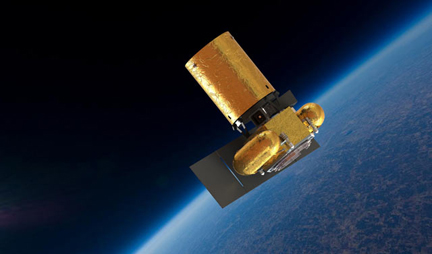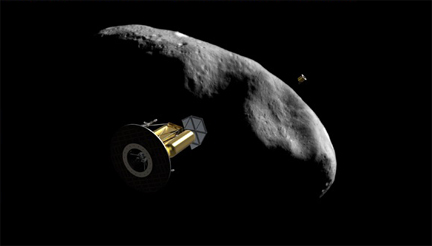Planetary Resources Inc. unveils plans for asteroid mining
04/24/2012 05:51 PM Filed in: Space News | Commercial Space
By WILLIAM HARWOOD
CBS News
Planetary Resources Inc. hopes to turn science fiction into reality with plans to identify near-Earth asteroids loaded with ice, precious metals and other raw materials and then to send robotic landers to selected targets to carry out mining operations. The idea is to return valuable ores to Earth or to convert water into rocket fuel to dramatically lower the cost of deep space exploration, company officials said Tuesday.
Despite the audacious nature of the company's goal, co-founder Eric Anderson told an enthusiastic crowd of supporters at the Museum of Flight in Seattle that Planetary Resources is serious, saying "this company is not about paper studies."
"This company is not about thinking and dreaming about asteroid mining," he said. "This company is about creating a space economy beyond the Earth, it's about building real hardware, it's about doing real things in space to move the needle forward. Not just talking about it. We've done enough of that. We're about doing."
If successful, "we hope to make a lot of money," Anderson said. "But we understand that's not going to happen overnight."
Even so, given the astronomical nature of the potential payoff -- "an (80-meter-wide) asteroid that would fit in this room would certainly have a hundred billion dollars plus of materials," Anderson said -- the wait may well be worth it.
"The pot of gold at the end of this rainbow, if it is successful, will be big," he said.
With funding and support from a variety of investors, including Google CEO Larry Page, Ross Perot Jr., Google Executive Chairman Eric Schmidt and Charles Simonyi, a former software architect with Microsoft who has made two trips to the International Space Station as a space tourist, Planetary Resources would appear to have the wherewithal to begin initial operations in low-Earth orbit over the next two years.
Few technical details were released Tuesday and it remains to be seen whether the company can turn its dream into a commercial reality. But Anderson laid out a step-by-step approach to the challenge of asteroid mining, a strategy that could take decades to fully implement.
In the near term, the company plans to launch a small, inexpensive space telescope to low-Earth orbit within the next two years to begin characterizing asteroids that pass relatively close to Earth. Some 9,000 near-Earth asteroids have been identified to date, including more than 1,500 that are as easy to reach as the moon, the company said.
Billed as a commercial space telescope, the Arkyd-100 series space telescope will be capable of studying deep space targets or looking back at planet Earth for a variety of commercial applications.
In phase two of the project, propulsion systems and additional instrumentation will be added to enable more sophisticated Arkyd-200 series spacecraft to fly so called asteroid "interceptor" missions. The goal is to quickly collect more precise data on nearby asteroids and targets of opportunity to help perfect the technology and to better assess possible candidates for future mining missions.
Adding a deep space laser communications system will permit Arkyd-300 spacecraft to carry out "rendezvous prospector" missions to more distant asteroids, flying in "swarms" of a half dozen or so to orbit a target and collect detailed information about its physical characteristics and chemical composition.
At that point, the company hopes to be in a position to begin actual mining operations, focusing first on water-rich asteroids and later on recovery and processing of precious metals. Water ice is particularly valuable because it can be used for drinking water, hydroponic irrigation and, when broken down into oxygen and hydrogen, rocket propellants and air.
"Being able to go to asteroids and mine them for water provides us with not only the ability to support life in space -- drinking water, growing food, protection from radiation in space -- but also propellant, fuel and oxidizer, that will allow us to open up deep space for human and robotic exploration, to drastically reduce the cost of space exploration," Anderson said. "The second most valuable materials we're going to find in space are the precious metals and the materials that are very difficult to find on Earth."
Chris Lewicki, president chief engineer of Planetary Resources, said the Arkyd-100 spacecraft will be small enough to hitch rides to low-Earth orbit as secondary payloads on other missions and will cost orders of magnitude less than a typical NASA science probe. A mockup of an Arkyd-100 on the stage at the news conference was about the size of a large suitcase.
"Planetary Resources' goal is to develop the resources of space," Lewicki said. "And in order to achieve this goal, we're going to need to dramatically reduce the cost of space exploration and specifically, asteroid exploration. We're going to combine the best practices of aerospace, we're also going to take a Silicon Valley style of innovation to create robotic explorers that cost one, maybe two orders of magnitude less than current systems."
While NASA, Japan and the European Space Agency have sent probes to a variety of asteroids, "it's cost us hundreds of millions of dollars, upwards of a billion in some cases," Lewicki said.
"We're going to do it for tens of millions of dollars, and we're charting a path that gets us to single digit millions per prospecting spacecraft. That's two orders of magnitude, or a factor of a hundred lower. That is bold. That is crazy, and that's what attracts me to this."
He said the company realizes it faces a difficult challenge and that "we're not always going to succeed. And when failure is not an option, success gets really expensive."
"We're approaching risk in a new way for space exploration," he said. "With our swarm expeditions, we're taking safety in numbers. We will live with, and we will learn from, our failures. And based on what we've learned, we'll implement the next series, which will begin the material collection and processing in support of asteroid mining."
CBS News
Planetary Resources Inc. hopes to turn science fiction into reality with plans to identify near-Earth asteroids loaded with ice, precious metals and other raw materials and then to send robotic landers to selected targets to carry out mining operations. The idea is to return valuable ores to Earth or to convert water into rocket fuel to dramatically lower the cost of deep space exploration, company officials said Tuesday.
Despite the audacious nature of the company's goal, co-founder Eric Anderson told an enthusiastic crowd of supporters at the Museum of Flight in Seattle that Planetary Resources is serious, saying "this company is not about paper studies."
 |
| A Planetary Resources Arkyd-100 space telescope in Earth orbit. The company hopes to send more advanced versions of the spacecraft to nearby asteroids to identify candidates for eventual mining missions. (Credit: Planetary Resources) |
If successful, "we hope to make a lot of money," Anderson said. "But we understand that's not going to happen overnight."
Even so, given the astronomical nature of the potential payoff -- "an (80-meter-wide) asteroid that would fit in this room would certainly have a hundred billion dollars plus of materials," Anderson said -- the wait may well be worth it.
"The pot of gold at the end of this rainbow, if it is successful, will be big," he said.
With funding and support from a variety of investors, including Google CEO Larry Page, Ross Perot Jr., Google Executive Chairman Eric Schmidt and Charles Simonyi, a former software architect with Microsoft who has made two trips to the International Space Station as a space tourist, Planetary Resources would appear to have the wherewithal to begin initial operations in low-Earth orbit over the next two years.
Few technical details were released Tuesday and it remains to be seen whether the company can turn its dream into a commercial reality. But Anderson laid out a step-by-step approach to the challenge of asteroid mining, a strategy that could take decades to fully implement.
In the near term, the company plans to launch a small, inexpensive space telescope to low-Earth orbit within the next two years to begin characterizing asteroids that pass relatively close to Earth. Some 9,000 near-Earth asteroids have been identified to date, including more than 1,500 that are as easy to reach as the moon, the company said.
Billed as a commercial space telescope, the Arkyd-100 series space telescope will be capable of studying deep space targets or looking back at planet Earth for a variety of commercial applications.
In phase two of the project, propulsion systems and additional instrumentation will be added to enable more sophisticated Arkyd-200 series spacecraft to fly so called asteroid "interceptor" missions. The goal is to quickly collect more precise data on nearby asteroids and targets of opportunity to help perfect the technology and to better assess possible candidates for future mining missions.
 |
| An Arkyd-200 spacecraft closes in on an asteroid for a detailed inspection in this computer graphic. (Credit: Planetary Resources) |
At that point, the company hopes to be in a position to begin actual mining operations, focusing first on water-rich asteroids and later on recovery and processing of precious metals. Water ice is particularly valuable because it can be used for drinking water, hydroponic irrigation and, when broken down into oxygen and hydrogen, rocket propellants and air.
"Being able to go to asteroids and mine them for water provides us with not only the ability to support life in space -- drinking water, growing food, protection from radiation in space -- but also propellant, fuel and oxidizer, that will allow us to open up deep space for human and robotic exploration, to drastically reduce the cost of space exploration," Anderson said. "The second most valuable materials we're going to find in space are the precious metals and the materials that are very difficult to find on Earth."
Chris Lewicki, president chief engineer of Planetary Resources, said the Arkyd-100 spacecraft will be small enough to hitch rides to low-Earth orbit as secondary payloads on other missions and will cost orders of magnitude less than a typical NASA science probe. A mockup of an Arkyd-100 on the stage at the news conference was about the size of a large suitcase.
"Planetary Resources' goal is to develop the resources of space," Lewicki said. "And in order to achieve this goal, we're going to need to dramatically reduce the cost of space exploration and specifically, asteroid exploration. We're going to combine the best practices of aerospace, we're also going to take a Silicon Valley style of innovation to create robotic explorers that cost one, maybe two orders of magnitude less than current systems."
While NASA, Japan and the European Space Agency have sent probes to a variety of asteroids, "it's cost us hundreds of millions of dollars, upwards of a billion in some cases," Lewicki said.
"We're going to do it for tens of millions of dollars, and we're charting a path that gets us to single digit millions per prospecting spacecraft. That's two orders of magnitude, or a factor of a hundred lower. That is bold. That is crazy, and that's what attracts me to this."
He said the company realizes it faces a difficult challenge and that "we're not always going to succeed. And when failure is not an option, success gets really expensive."
"We're approaching risk in a new way for space exploration," he said. "With our swarm expeditions, we're taking safety in numbers. We will live with, and we will learn from, our failures. And based on what we've learned, we'll implement the next series, which will begin the material collection and processing in support of asteroid mining."